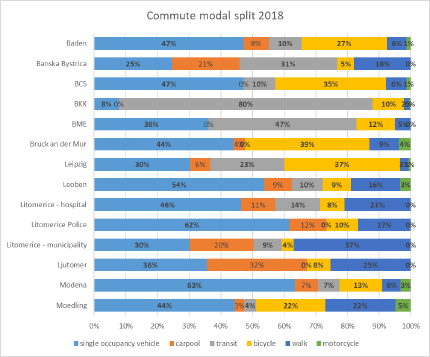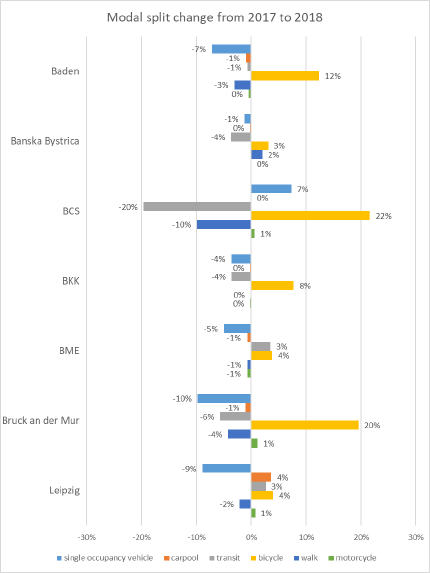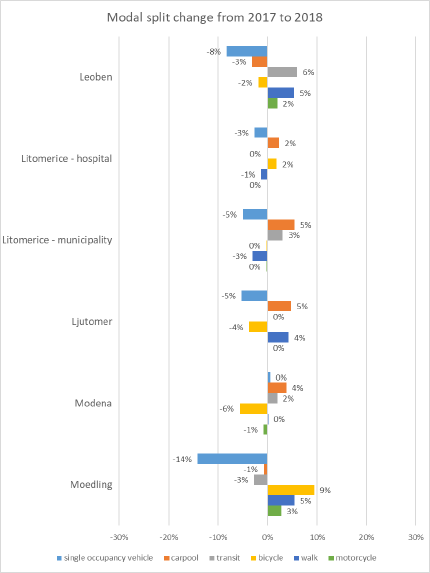2nd MODAL SPLIT ON DURING MEASUREMENT
6. August 2018
The results of the 1st survey before measurement were published on our website in July 2017 - here can you find the article. Results of the 1st survey showed a high potential of mode-shifts from car-usage to other model of transport.
Now you can read the results of the 2nd survey - during measurement.
The key indicator for MOVECIT project is a modal split statistic, which provides an overall estimation of mobility behaviour. Modal split (or modal share) is a number or a share of trips by each transportation mode. For the purposes of this survey a trip is defined as a person’s change in location with an origin and destination, which lies beyond the property on which the participating person lives. The survey was carried out in 14 workplaces across 6 countries.
In travel behavior survey 1.824 employees were included: 503 from Czech Republic (Hospital, Municipality of Litomerice and Police), 190 from Hungary (BME, BKK and Municipality of Bekescsaba), 29 from Slovenia (Municipality of Ljutomer), 98 from Slovakia (Municipality of Banska Bystrica), 200 from Austria (Municipality of Baden, Bruck, Leoben and Moedling), 691 from Italy (City of Modena) and 113 from Germany (City of Leipzig).
The 14 municipalities and institutions taking part in MOVECIT project differ strongly in nature and size of the city or workplaces as well as in infrastructural aspects like the extension of bike network or public transport systems.
Most of the 14 examined municipalities and institutions have one thing in common: the predominant car usage. This situation has not changed a lot compared to the first survey. In 3 of 14 cases the modal split shares of car-usage (single occupancy vehicle) was 50 % or higher. Modena (Italy) shows the highest share of car-usage in modal split results with 63 %, followed by Litomerice Police with 62% and Leoben (Austria) with 54%.
Exceptional cases are the Budapest Centre of Transport (Hungary), which has 80% share of public transport whereas in Ljutomer (Slovenia) employees do not commute by public transport at all (0%).
Litomerice Municipality (Czech Republic) shows the highest mode share for walking (37%). In Modena (Italy) and Leipzig (Germany), both densely urbanized cities, and also at the Budapest University (Hungary) walking shares are low.
Leipzig and Bruck an der Mur show the best share for cycling with 37 % and 39 %.
Ljutomer and Banska Bystrica have significant shares of car-pooling (32 % and 21 %).
Motorcycling seams not to be relevant in the 13 MOVECIT municipalities and institutions.

Modal split change between 2017 and 2018
The below tables show the compared results from 2017 and 2018, which indicate the first changes and trends in commuting behaviour in the participating municipalities and institutions. The light blue bars show the changes in single car usage. The car usage amongst the employees has dropped in nearly all cases, which is a pleasant trend concerning the MOVECIT project goals.
The summarized mode changes provide results that indicate a trend of decreasing car usage for commuting and an increase in cycling. Single occupancy car use dropped by 5 %, carpooling increased by 1 %. Unfortunately, public transport and walking decreased by 1%, whereas cycling increased by 6%.


